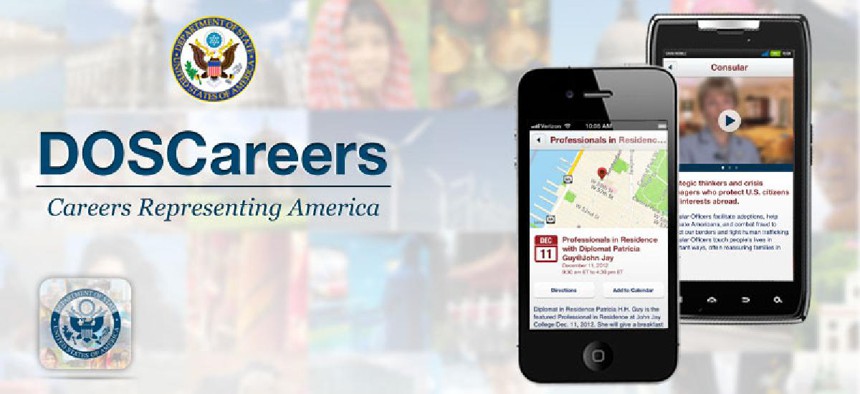State Department Launches New App for Prospective Diplomats

State Department
The app can help students prepare for the Foreign Service exam.
A new State Department mobile application gives prospective Foreign Service officers a taste of what could be in store for them.
The app, which is being promoted online and during career fairs, includes slick video interviews with diplomats representing the department’s different specialties, profiles of embassy life in different nations, basic information about joining the Foreign Service and hundreds of sample questions to prepare for the Foreign Service Officer Test.
The app also includes information about applying to join the Foreign Service and a calendar of career events.
The app was developed with partial funding from the IT Innovation Fund at State’s Office of eDiplomacy, developer Rachel Friedland said. Friedland is the State Department’s recruitment advertising and marketing manager.
The app is available on Apple and Android devices.
Could you make the grade?
Here are a few sample questions from the app’s Test Yourself section. The questions do not appear on the Foreign Service entrance exam but they “explore areas that are included in the test.” For a full set of questions and other information about joining the Foreign Service click here or find the app in the iTunes and Android app stores.
1. World History and Geography:
Proportional representation in voting has had the greatest impact on governing in which of the following countries?
A. Australia
B. Ireland
C. Israel
D. New Zealand
2. Economics:
The Franklin/ Templeton mutual funds company recently introduced a new mutual fund that invests in companies in four rapidly developing countries. The fund, called the BRIC fund, refers to which set of countries?
A. Belarus, Rwanda, Ireland, Czech Republic
B. Belgium, Romania, Indonesia, Chile
C. Bolivia, Romania, Italy, Colombia
D. Brazil, Russia, India, China
3. Technology:
Which best describes the icons that appear on a Microsoft Word toolbar for aligning text?
A. The letters L,C,R
B. Series of six horizontal lines
C. Pictures of a page with text
D. Arrows pointing left, right, and up and down
4. Communication:
Which of the following policies, which mandated that media broadcasters present a diversity of perspectives on contentious or controversial subjects in order to prevent domination by a single viewpoint, was repealed by the U.S. Congress in 1987?
A. The Communications Decency Act
B. The Equal Time Rule
C. The Media Bias Rule
D. The Fairness Doctrine
5. U.S. Government
Which of the following voting systems usually produces the highest voter turnout?
A. Proportional representation with a low threshold
B. Plurality voting with single-member districts
C. Majority voting with run-off elections
D. Preferential voting utilizing second choices
6. U.S. Society and Culture:
The action by which a single union attempts to close down an entire construction site or project
A. Is known as a secondary boycott
B. Represents an illegal restraint of trade
C. Is called common situs picketing
D. Was permitted by Congress in 1977
7. Management:
A Foreign Service Officer attempting to help a foreign citizen is struggling with a language barrier. The most effective way the FSO might facilitate communication is to
A. Pantomime the problem and related questions
B. Speak very loudly, breaking words into distinct syllables
C. Express frustration with the situation
D. Break the conversation down into small bits, using short sentences and simple questions
Answer key: 1=C; 2=D; 3=B; 4=D; 5=A; 6=C; 7=D






